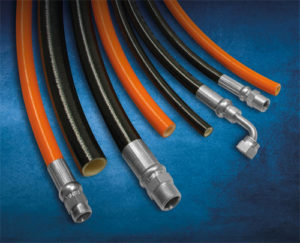 Thermoplastic hoses are common in both mobile and industrial equipment, and they are widely used in medium-to-high pressure hydraulic applications. Related products are often specified for handling compressed air and other gases, transporting chemicals, and in water-cleaning and paint-spray operations.
Thermoplastic hoses are common in both mobile and industrial equipment, and they are widely used in medium-to-high pressure hydraulic applications. Related products are often specified for handling compressed air and other gases, transporting chemicals, and in water-cleaning and paint-spray operations.
Like its rubber counterpart, thermoplastic hydraulic hose typically has an inner tube, one or more layers of reinforcement, and a protective cover. Where they differ, as the name implies, is in the materials of construction.
The specific polymers and type of design depend on numerous factors like pressure capability, compatibility with the fluids to be handled, temperature operating range, abrasion resistance, and the ability to withstand attack from chemicals, solvents, cleaning fluids, saltwater, ozone and UV radiation.
 The inner tube, which contains the fluid, is made from plastics such as polyamide, polyester, and even fluoropolymers. The cover protects the internal reinforcement and tube, and it is typically made of materials like polyester, polyethylene, polyurethane, and PVC. Extreme-cold applications might require alternative materials like polyester elastomer or polytetrafluoroethylene (PTFE); and high temperatures might demand polymers like special polyolefins, polyamides or PTFE.
The inner tube, which contains the fluid, is made from plastics such as polyamide, polyester, and even fluoropolymers. The cover protects the internal reinforcement and tube, and it is typically made of materials like polyester, polyethylene, polyurethane, and PVC. Extreme-cold applications might require alternative materials like polyester elastomer or polytetrafluoroethylene (PTFE); and high temperatures might demand polymers like special polyolefins, polyamides or PTFE.
Thermoplastic hose also generally has one or two reinforcing layers that provide needed strength and adequate pressure-holding ability. The reinforcement layers usually have a braided construction, made from materials like polyester, polyamide or aramid fibers, or steel wire.
A critical aspect of thermoplastic hose construction is how the tube, reinforcement and cover are bonded together. Thermal and chemical bonding methods ensure strong adhesion because thermoplastic materials can be re-melted during the production process. As a result, both the tube OD and cover ID materials can migrate between reinforcing fibers, creating a sturdy attachment between the three layers.
For users, thermoplastic hose offers a number of benefits over rubber hydraulic hose. As mentioned above, these products can be formulated to easily handle extreme temperatures and environmental attack that would prematurely degrade rubber hoses. And manufacturers can tailor performance characteristics like flexibility and kink resistance, and even customize products for color or shape.
The tube typically has a smooth internal surface that permits highly efficient flow and reduces flow losses. It also tends to offer low expansion even at maximum working pressure. And the plastic tube resists erosion, which helps maintain overall system cleanliness.
Another benefit is that during the production process, thermoplastic hose has a self-supporting inner tube that is cured without a mandrel. (In contrast, rubber hose is manufactured on an internal mandrel that provides support and maintains tube dimensions during processing, and it must be subsequently removed.) Therefore, thermoplastic hose can be made in extremely long lengths. Some special offshore applications take advantage of continuous hose in lengths of up to 8,000 meters.
A related benefit is that because manufacturing does not require a mandrel, ID dimensions of 1/16 in. or smaller are possible. The smallest rubber hoses typically have an ID of 3/16 in. This also permits a tighter bend radius.
Likewise, the inherent strength of the polymers used in these hoses permits thinner tubes and covers—and, therefore, more-compact overall dimensions for equal flow—compared with rubber hose. The resulting products with a smaller OD in proportion to the ID are important when routing in tight spaces or fitting many hoses in a small available volume.
Add to that, weight per a given length of thermoplastic hose can be substantially less—often 40 to 60% less—than that of comparable rubber hose.
Standard hoses come in straight lengths and are often stored as coils. But some thermoplastic designs can be thermally formed into custom 3D shapes, such as with predefined bends and angles to meet specific application requirements, easy routing and quick installation.
Likewise, two or more hoses can be bonded into a single assembly that eliminates problems like routing multiple hoses individually, or letting them rub against each other and potentially abrade the covers. It also reduces part counts and generally, lowers costs.

Leave a Reply